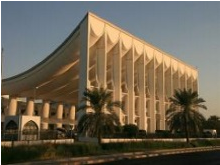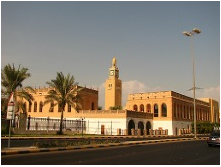
On 19 June 1961, the Amir of Kuwait, Shaikh ‘ Abd Allah Al-Salim Al-Sabah announced the termination of the 1899 Agreement with Britain for being inconsistent with the sovereignty and independence of Kuwait’. The first act the Amir performed shortly after independence was declared was to issue an Amir decree calling for the election of a Constituent Assembly to draft a constitution for Kuwait to be based on ‘democratic principles taken from the realities and objectives of Kuwait’, and to present it to the Amir for his approval within a period of one year, it took the Assembly seven long sessions to conclude discussion of the draft constitution which was finally presented to the
Amir on 9 November 1962, who immediately approved it without amendment on 11 November 1962.
The system of government was to be ‘ democratic, under which sovereignty resides in the people, the source of all powers.’ The individual rights of property, capital, and work were considered fundamental constituents of the social structure of the state and of national wealth. The national economy was to be based on social justice and on co-operation between public and private activities.
The system of government was based on the principle of the separation of powers ‘in co-operation with each other’. Legislative power was invested in the Amir and the cabinet and judicial power was invested in the courts. The Amir was the head of state whose person was immune and inviolable and would exercise his powers through his ministers who were collectively and individually responsible to him. He was also to declare defensive war by decree as offensive war was prohibited. The Amir had the right to initiate, sanction, and promulgate laws. No law could be promulgated unless it had been passed by the National Assembly (Kuwait Parliament) and was sanctioned by the Amir.
The National Assembly (Kuwait Parliament) would is composed of fifty members (ten from each of the five districts) in addition to those Ministers who were not elected (up to one third of the elected members). Each Assembly member is a member of the National Assembly (Kuwait Parliament) has the right to initiate bills and to address to the prime minister and the ministers questions and interpellations with regard to matters falling within their competence. Ministers were made individually responsible to the National Assembly (Kuwait Parliament) for the affairs of their ministries. Withdrawal of confidence from a minister required an absolute majority of the 50 members constituting the Assembly excluding ministers (not the majority of only those present). If the National Assembly (Kuwait Parliament) decided, in the same manner, that it could not co-operate with the prime minister the matter would be submitted to the Amir who could either relieve the prime minister of office and appoint a new cabinet, or dissolve parliament..

In choosing a system of government for Kuwait the Constituent Assembly was aware that there were two main systems before it, one parliamentary and the other presidential, and thus attempted to incorporate what it considered to be the best aspects of both. It first sought to incorporate, the concept of cabinet responsibility before parliament by making the cabinet responsible before the Amir and the National Assembly (Kuwait Parliament).
The Amir as the head of state is a symbol of respect who remains above responsibility and exercises his powers through, his ministers. The Constituent Assembly then gave members of the Assembly the right to question the prime; Minister and his ministers Mindful, however, of what it ‘considered’ to be the pitfalls of the parliamentary system, the Committee put certain restraints on them. ‘It did that’. In the hope of ensuring greater stability, a main feature of the presidential system.
